Papers by Telmah Telmadarrehei
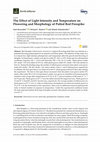
Horticulturae, Oct 25, 2018
Red firespike (Odontonema strictum) is a tropical flowering plant that was selected as a potentia... more Red firespike (Odontonema strictum) is a tropical flowering plant that was selected as a potential flowering potted plant for its attractive red floral spikes. The objective of this study was to evaluate how light intensity, photoperiod, and temperature affect the growth and flowering of firespike. In Experiment 1, plants were grown under 0%, 45%, or 65% shade and two photoperiod conditions; long-day (LD = ≥14 h) and short-day (SD = 9 h), for 16 weeks. Plants grown under 45% shade + LD were tallest at 35.9 cm, while plants grown under 65% shade + SD were shortest at 22.8 cm. During the finishing stage, the number of inflorescences increased when plants were grown under 45% shade + SD, 45% shade + LD, and no shade, with 6, 7, and 9 inflorescences, respectively. In addition, the first open flower was observed in the 0% shade group (control) 92 days after starting the experiment. The time to first open flower increased when the plants were grown under 65% shade, either under SD or LD. In Experiment 2, plants were grown in controlled environment growth chambers with average daily temperatures of 15, 25, or 35 • C and an irradiance of 200 µmol•m −2 •s −1 for 9 h per day. Plants grown at 25 • C were the tallest and had the largest leaf area. Plants grown at 15 and 35 • C had 28% and 22% less leaf area, respectively. The average number of inflorescences in plants grown at 25 • C was 1.6, while no inflorescence development was observed in plants grown at 15 or 35 • C by the termination of the experiment. There were no differences between plant growth index or branch number in response to temperature. Under the experimental conditions tested, the most rapid and uniform flowering of firespike occurred when plants were grown under no shade or at 25 • C.
Invasive plant science and management, Apr 18, 2024
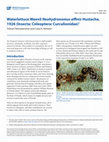
EDIS
Neohydronomus affinis Hustache is known as the waterlettuce weevil (Figure 1). It is a biological... more Neohydronomus affinis Hustache is known as the waterlettuce weevil (Figure 1). It is a biological control agent of the floating plant, waterlettuce, Pistia stratiotes Linnaeus (Araceae) (O’Brien & Wibmer, 1989; Center et al., 2002). Waterlettuce is found in tropical and subtropical regions of the world. It infests slow-moving streams, waterways, lakes, and rivers, forming dense floating mats that are composed of several rosettes connected by stolons (runner stems). The presence of waterlettuce mats diminishes biological diversity and generates obstructions for boating, waterflow, and aquatic organisms (Cordo & Sosa, 2000; Dray & Center, 2002). Even though waterlettuce was documented by explorer William Bartram in Florida before 1765 (plants-archive.ifas.ufl/plant-directory), it is listed as a class II prohibited aquatic plant in the State of Florida. There are three species in the genus Neohydronmus, all of which originate from South and Central America. These weevils are subaquatic...
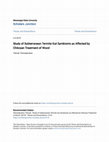
The overall aim of this study was to investigate the potential influence of chitosan, a biodegrad... more The overall aim of this study was to investigate the potential influence of chitosan, a biodegradable and antimicrobial compound, on termite hindgut symbionts. For this purpose, a morphological quantifying technique was conducted on the protist community’s hindgut after feeding termites on chitosan-treated wood. The aim was to characterize the diversity of protist species in the economically important dark southern subterranean termite, Reticulitermes virginicus. A molecular phylogenetic analysis of the V3 and V4 hyper-variable regions of 16S ribosomal RNA (rRNA) gene of the bacterial community in the hindgut of R. virginicus was performed on termites exposed to chitosan treatment. Light microscopy visualization of protist species residing in the hindgut of workers showed presence of ten protist species both in the control sample and in termites fed a low concentration of chitosan. In this study, the coexistence of two species of the genus Trichonympha (T. agilis and T. burlesquei) ...
Biocontrol Science and Technology
American-Eurasian Journal of Agricultural and Environmental Science, 2010
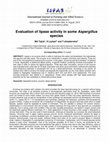
Lipase is an enzyme which is able to hydrolyze the esters and breakdown the triglycerides into gl... more Lipase is an enzyme which is able to hydrolyze the esters and breakdown the triglycerides into glycerol and fatty acids. This enzyme is so noteworthy in organic chemistry and industry. Fungi are one of the microorganisms producing this enzyme. In this paper, screening was done between 10 species of fungi, Aspergillus, to determine lipase activity. A specific medium containing minerals and soybean oil was used in order to induce the lipase production. Three days after inoculation, amount of the enzyme was evaluated every other day for 20 days. Evaluation was done using colorimetric method with substrate para-nitrophenyl palmitate in wavelength 410 nm by a spectrophotometer. According to the results, all isolates were able to produce the lipase and degrade the triglyceride; but the most lipase activities were related to Aspergillus caespitosus and A. Ostianus 39.9 U/ml and 36.01 U/ml respectively. The most biomass production was related to A. caespitosus. These native isolates with hi...
Research Journal of Medicinal Plant, 2012
World Applied Sciences Journal

Iranian Journal of Plant Pathology, 2012
Rice sheath spot agent was first reported from California, Arkansas and Louisiana as Trichoderma ... more Rice sheath spot agent was first reported from California, Arkansas and Louisiana as Trichoderma sp. (Tullis, 1934). Then Ryker & Gooch introduced R. oryzae as the correct agent. Waitea circinata has WAG-O anastomosis group related to R. oryzae. The fungus was not reported from Iran. A Rhizoctonia isolate was isolated from corn sheath bearing sheath blight symptoms. After fourteen days the colony was changed white to salmon and sclerotia were waxy, soft and often sunken in agar. Sclerotia were irregular and salmon in colour. The species as pathogen has been reported from Japan, Cambodia, Thailand, Taiwan, Philippines, USA, West Africa and Brazil. Hoshioka and Mankino (1969) reported that this fungus was found in subtropical and tropical rice growing regions and regarding to this report, R. oryzae is confined to these climates due to its low cold tolerance threshold. Although sheath spot has observed in southeastern Australia which is outside the tropical and sub-tropical regions (La...
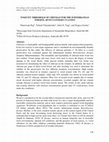
Chitosan is a hydrophilic and biodegradable polysaccharide with antimicrobial properties. It has ... more Chitosan is a hydrophilic and biodegradable polysaccharide with antimicrobial properties. It has low toxicity to non-target organisms and is considered an environmentally friendly preservative. In this study, the efficacy of chitosan polymer (> 50 kDa) as a wood preservative was evaluated against the subterranean termites Reticulitermes flavipes (Isoptera: Rhinotermitidae). The treatability and leachability of chitosan from wood was also studied. Visual ratings and mass losses were used to assess the degree of termite damage to the wood blocks, while percent termite mortality after two weeks was measured for determining the effect of chitosan on the termites. In addition, the mass of chitosan per gram of dried wood before and after leaching was used to determine the stability of the preservative for five different treatment concentrations. High termite mortality was observed in termites exposed to wood treated with 3%, 4% and 5% chitosan solution-treated samples, while only 10% m...
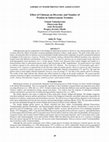
Although protist species composition in the hindgut of subterranean termites is known to vary amo... more Although protist species composition in the hindgut of subterranean termites is known to vary among termite species, less is known about the effects of biocides on protist population dynamics within a single species. The goal of this study was to observe the potential effect of chitosan, an environmentally friendly antimicrobial compound, on protist communities harbored in hindguts of Reticulitermes virginicus. Workers of two termite colonies collected from different locations were exposed to treated wood with different concentrations of chitosan (0.5%, 1% and 2%) and two sets of control-treated (water and acetic acid-impregnated) wood specimens over a 14-day period. Protists were dissected from termite hindgut and loaded on a hemocytometer slide to count protist species under a light microscope at 400× magnification. Ten protist species were found in colonies exposed to the control and wood treated with 0.5% chitosan. The coexistence of Trichonympha agilis and T. burlesquei in R. v...
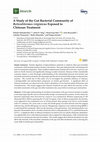
Insects
A thorough understanding of microbial communities in the gut of lower termites is needed to devel... more A thorough understanding of microbial communities in the gut of lower termites is needed to develop target-specific and environmentally benign wood protection systems. In this study, the bacterial community from Reticulitermes virginicus was examined by Illumina sequencing of 16S ribosomal RNA (rRNA) spanning the V3 and V4 regions. Prior to library preparation, the termites were subjected to five treatments over an 18-day period: three groups were fed on wood treated with 0.5% chitosan, 25% acetic acid, or water, the fourth group was taken directly from the original collection log, and the fifth group was starved. Metagenomic sequences were analyzed using QIIME 2 to understand the treatments’ effects on the dynamics of the gut bacteria. Four dominant phyla were detected: Bacteroidetes (34.4% of reads), Firmicutes (20.6%), Elusimicrobia (15.7%), and Proteobacteria (12.9%). A significant effect of chitosan treatment was observed in two phyla; Firmicutes abundance was significantly low...
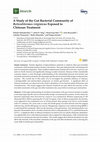
Insects
A thorough understanding of microbial communities in the gut of lower termites is needed to devel... more A thorough understanding of microbial communities in the gut of lower termites is needed to develop target-specific and environmentally benign wood protection systems. In this study, the bacterial community from Reticulitermes virginicus was examined by Illumina sequencing of 16S ribosomal RNA (rRNA) spanning the V3 and V4 regions. Prior to library preparation, the termites were subjected to five treatments over an 18-day period: three groups were fed on wood treated with 0.5% chitosan, 25% acetic acid, or water, the fourth group was taken directly from the original collection log, and the fifth group was starved. Metagenomic sequences were analyzed using QIIME 2 to understand the treatments’ effects on the dynamics of the gut bacteria. Four dominant phyla were detected: Bacteroidetes (34.4% of reads), Firmicutes (20.6%), Elusimicrobia (15.7%), and Proteobacteria (12.9%). A significant effect of chitosan treatment was observed in two phyla; Firmicutes abundance was significantly low...
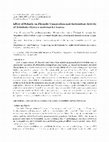
Due to high content of phenolic compounds that exhibit pharmacological activities such as antioxi... more Due to high content of phenolic compounds that exhibit pharmacological activities such as antioxidant, the leaves of artichoke have important drug values. In present experiment, the effect of salt stress on phenolic compounds and antioxidant activity of artichoke leaves grown up in the field and pot conditions were studied. The salinity of the soil varied from 1.5 to 20.6 dS m-1 and 1.3 to 29 dS m-1 in pot and field experiments, respectively. Results showed that the highest amount of these compounds was recorded at 6.9 and 6.45 dS m-1 in pot and field experiments, respectively. As salinity increased up to 6 in both experiment, a reduction in total phenol and flavonoid was observed. Results showed that the antioxidant activity of leaf, positively increased by the salinity levels; in both trials the maximum antioxidant activity (IC50 = 0.01 mg mL-1) was observed at highest level of salinity. Similar to phenolic and flavonoid compounds the contents of chlorogenic and caffeic acids were at their highest levels in moderate salinity. Caffeic and chlorogenic acids accumulation was limited by high level of salinity without reduction in antioxidant activity. It can be concluded that at under the moderate and high salinity conditions, health-promoting compounds (polyphenol contents) in artichoke leaves are enhanced.
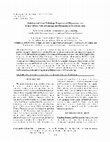
Rhizoctonia
is a soil inhabitant fungus with many species and wide host range. As a facultative ... more Rhizoctonia
is a soil inhabitant fungus with many species and wide host range. As a facultative parasite, Baiting is a shortcut for its isolation from soil. In current research, some soil samples were preparedfrom soils of cultivated fields and gardens of Golestan and Mazandaran provinces. Some sheath blight bearingsymptom plant materials were subjected to sampling. Many
Rhizoctonia
isolates were isolated then cultureswith orange to red soft sclerotes and orange mycelium were identified as
R. zeae.
Fifty seven from total of seventy had successful anastomosis with
R
.
zeae
CBS 384.34 as standard. Pathogenic ability of some isolateswere tested on young seedling in petri plates On corn, wheat, cucumber, squash and radish. Pathogenicity testshad positive results as rot symptoms on emerged roots. This is the first report for pathogenicity of
R.zeae
onwheat sheath, cucumber, squash and radish from Golestan and Mazandaran provinces. Baiting is an easy anduseful method on preliminary ecological and pathological studies of
Rhizoctonia
spp.
Rhizoctonia zeae causes root rot and sheath blight on corn (Zea mays) and several other
gramine... more Rhizoctonia zeae causes root rot and sheath blight on corn (Zea mays) and several other
gramineous plants. In order to determine the genetic diversity of the R. zeae population in
Mazandaran and Golestan provinces, samples were collected from cultivatd soils of both
provinces in 2011 and 2012.The identity of isolates as R. zeae were verified by
amplification and sequencing of the 18S and 28S rDNA of five representative isolates.
Genetic diversity of 20 isolates from different geographic regions were assessed by
amplification of the ITS region of rDNA by PCR, using ITS4 and ITS5 primers and
sequencing of the amplified fragments. The isolates appeared to be genetically
heterogeneous and were differentiated into four clusters based on their ITS sequences.
There was substantial correlation between the morphological variation and genetic
heterogeneity observed among isolates.

Uploads
Papers by Telmah Telmadarrehei
is a soil inhabitant fungus with many species and wide host range. As a facultative parasite, Baiting is a shortcut for its isolation from soil. In current research, some soil samples were preparedfrom soils of cultivated fields and gardens of Golestan and Mazandaran provinces. Some sheath blight bearingsymptom plant materials were subjected to sampling. Many
Rhizoctonia
isolates were isolated then cultureswith orange to red soft sclerotes and orange mycelium were identified as
R. zeae.
Fifty seven from total of seventy had successful anastomosis with
R
.
zeae
CBS 384.34 as standard. Pathogenic ability of some isolateswere tested on young seedling in petri plates On corn, wheat, cucumber, squash and radish. Pathogenicity testshad positive results as rot symptoms on emerged roots. This is the first report for pathogenicity of
R.zeae
onwheat sheath, cucumber, squash and radish from Golestan and Mazandaran provinces. Baiting is an easy anduseful method on preliminary ecological and pathological studies of
Rhizoctonia
spp.
gramineous plants. In order to determine the genetic diversity of the R. zeae population in
Mazandaran and Golestan provinces, samples were collected from cultivatd soils of both
provinces in 2011 and 2012.The identity of isolates as R. zeae were verified by
amplification and sequencing of the 18S and 28S rDNA of five representative isolates.
Genetic diversity of 20 isolates from different geographic regions were assessed by
amplification of the ITS region of rDNA by PCR, using ITS4 and ITS5 primers and
sequencing of the amplified fragments. The isolates appeared to be genetically
heterogeneous and were differentiated into four clusters based on their ITS sequences.
There was substantial correlation between the morphological variation and genetic
heterogeneity observed among isolates.
is a soil inhabitant fungus with many species and wide host range. As a facultative parasite, Baiting is a shortcut for its isolation from soil. In current research, some soil samples were preparedfrom soils of cultivated fields and gardens of Golestan and Mazandaran provinces. Some sheath blight bearingsymptom plant materials were subjected to sampling. Many
Rhizoctonia
isolates were isolated then cultureswith orange to red soft sclerotes and orange mycelium were identified as
R. zeae.
Fifty seven from total of seventy had successful anastomosis with
R
.
zeae
CBS 384.34 as standard. Pathogenic ability of some isolateswere tested on young seedling in petri plates On corn, wheat, cucumber, squash and radish. Pathogenicity testshad positive results as rot symptoms on emerged roots. This is the first report for pathogenicity of
R.zeae
onwheat sheath, cucumber, squash and radish from Golestan and Mazandaran provinces. Baiting is an easy anduseful method on preliminary ecological and pathological studies of
Rhizoctonia
spp.
gramineous plants. In order to determine the genetic diversity of the R. zeae population in
Mazandaran and Golestan provinces, samples were collected from cultivatd soils of both
provinces in 2011 and 2012.The identity of isolates as R. zeae were verified by
amplification and sequencing of the 18S and 28S rDNA of five representative isolates.
Genetic diversity of 20 isolates from different geographic regions were assessed by
amplification of the ITS region of rDNA by PCR, using ITS4 and ITS5 primers and
sequencing of the amplified fragments. The isolates appeared to be genetically
heterogeneous and were differentiated into four clusters based on their ITS sequences.
There was substantial correlation between the morphological variation and genetic
heterogeneity observed among isolates.